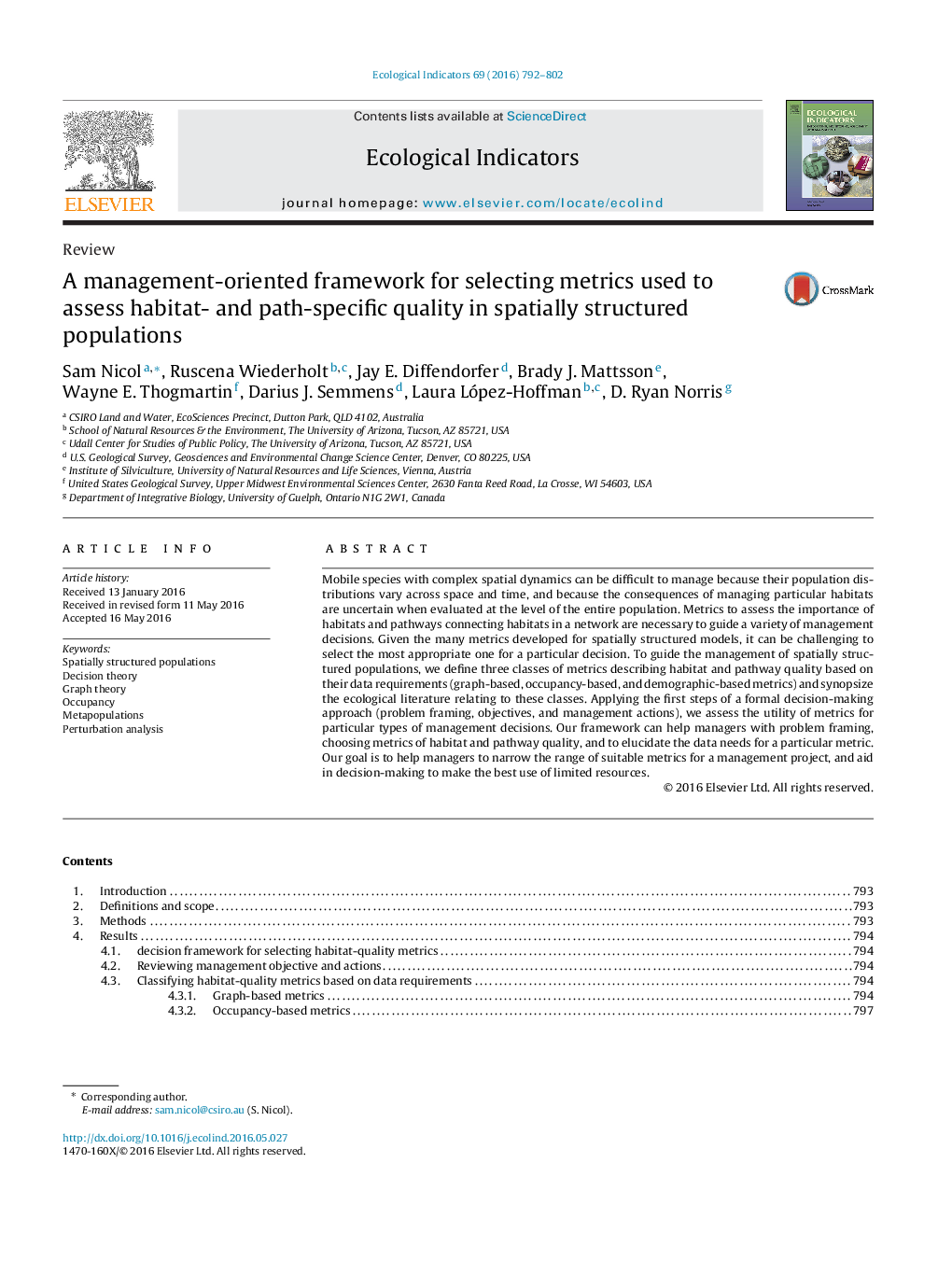| کد مقاله | کد نشریه | سال انتشار | مقاله انگلیسی | نسخه تمام متن |
|---|---|---|---|---|
| 6293352 | 1617133 | 2016 | 11 صفحه PDF | دانلود رایگان |
عنوان انگلیسی مقاله ISI
A management-oriented framework for selecting metrics used to assess habitat- and path-specific quality in spatially structured populations
ترجمه فارسی عنوان
یک چارچوب مدیریت گرا برای انتخاب پارامترهای مورد استفاده برای ارزیابی کیفیت زندگی زیستگاه و مسیر در جمعیت های ساختاری فضایی
دانلود مقاله + سفارش ترجمه
دانلود مقاله ISI انگلیسی
رایگان برای ایرانیان
کلمات کلیدی
جمعیت متشکل از فضایی، تئوری تصمیم گیری، نظریه گراف، تصرف، جمعیت متقابل، تجزیه و تحلیل اختلال،
ترجمه چکیده
گونه های متحرک با دینامیک فضایی پیچیده می توانند مدیریت شوند، زیرا توزیع جمعیت آنها در فضا و زمان متفاوت است و به همین علت است که پیامدهای مدیریت زیستگاه های خاص هنگام ارزیابی در سطح کل جمعیت نامشخص است. معیارهایی برای ارزیابی اهمیت زیستگاه ها و مسیر های اتصال زیستگاه ها در یک شبکه برای هدایت انواع تصمیمات مدیریت ضروری است. با توجه به معیارهای زیادی که برای مدلهای فضایی ساختار یافته تهیه شده است، می توان برای انتخاب یک تصمیم مناسب، مناسب ترین انتخاب را انتخاب کرد. برای هدایت مدیریت جمعیت های ساختاری فضایی، ما سه طبقه از معیارهای توصیف کیفیت زیستگاه و مسیر را براساس الزامات داده ها (مبتنی بر گرافیتی، مبتنی بر اشغال و معیارهای جمعیت شناختی) تعریف می کنیم و ادبیات زیست محیطی مربوط به این کلاس ها را هماهنگ می کنیم. با اعمال مراحل اول تصمیم گیری رسمی رسمی (قالب بندی مشکل، اهداف و اقدامات مدیریتی)، ما ابزار سنجش برای انواع تصمیمات مدیریت را ارزیابی می کنیم. چارچوب ما می تواند به مدیران کمک کند تا با مشکل برآوردن، انتخاب معیارهای کیفیت زیستگاه و مسیر و مشخص نمودن نیازهای داده ها برای یک متری خاص. هدف ما این است که برای کمک به مدیران برای محدود کردن دامنه معیارهای مناسب برای یک پروژه مدیریت، و کمک به تصمیم گیری برای بهترین استفاده از منابع محدود.
موضوعات مرتبط
علوم زیستی و بیوفناوری
علوم کشاورزی و بیولوژیک
بوم شناسی، تکامل، رفتار و سامانه شناسی
چکیده انگلیسی
Mobile species with complex spatial dynamics can be difficult to manage because their population distributions vary across space and time, and because the consequences of managing particular habitats are uncertain when evaluated at the level of the entire population. Metrics to assess the importance of habitats and pathways connecting habitats in a network are necessary to guide a variety of management decisions. Given the many metrics developed for spatially structured models, it can be challenging to select the most appropriate one for a particular decision. To guide the management of spatially structured populations, we define three classes of metrics describing habitat and pathway quality based on their data requirements (graph-based, occupancy-based, and demographic-based metrics) and synopsize the ecological literature relating to these classes. Applying the first steps of a formal decision-making approach (problem framing, objectives, and management actions), we assess the utility of metrics for particular types of management decisions. Our framework can help managers with problem framing, choosing metrics of habitat and pathway quality, and to elucidate the data needs for a particular metric. Our goal is to help managers to narrow the range of suitable metrics for a management project, and aid in decision-making to make the best use of limited resources.
ناشر
Database: Elsevier - ScienceDirect (ساینس دایرکت)
Journal: Ecological Indicators - Volume 69, October 2016, Pages 792-802
Journal: Ecological Indicators - Volume 69, October 2016, Pages 792-802
نویسندگان
Sam Nicol, Ruscena Wiederholt, Jay E. Diffendorfer, Brady J. Mattsson, Wayne E. Thogmartin, Darius J. Semmens, Laura López-Hoffman, D. Ryan Norris,
